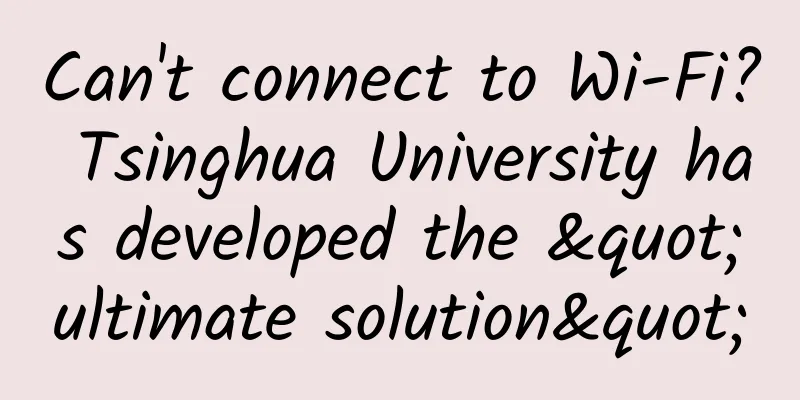Can't connect to Wi-Fi? Tsinghua University has developed the "ultimate solution"

|
While Wi-Fi is one of the greatest inventions of the last century (can anyone dispute that?), it's also one of the most anxiety-inducing technologies.
Can't connect to Wi-Fi? You're not alone. After 400 million attempts to connect, a research team from Tsinghua University says they've found the cause of the failure and have a solution. First, let me introduce the steps of Wi-Fi connection:
The team used an Android software called Wi-Fi Manager, which can record the time taken for each step of connecting to Wi-Fi. They said that according to experimental results, the quality and performance of current Wi-Fi networks are far from satisfactory: 45% of the time, connections fail. In the experiment, the time it took to connect to Wi-Fi varied greatly: 15% of the connections took more than 5 seconds, and 5% took more than 10 seconds. There are many indicators used to judge the quality of Wi-Fi networks, including throughput, latency, etc. However, the probability of successfully connecting to a Wi-Fi node and the time it takes to set up the connection are the important factors affecting the user experience. The researchers also said that although signal strength has a great impact on the connection process, only by understanding how the router works can the problem be truly solved. "We found that while signal strength is important, knowing the patterns of Wi-Fi access points and mobile devices can be a good predictor of how long it will take to establish a connection." Whether the Wi-Fi network was public or private was another important factor. They found that private networks were significantly faster and had a higher success rate in connecting. In addition, the team proposed a way to use AI to improve the success rate of connection: automatic scanning through AI algorithms to find the best network. "Through comprehensive measurements and detailed analysis, we proposed a Wi-Fi access node selection algorithm based on machine learning." “This algorithm uses the characteristics of Wi-Fi access points as input to the machine learning model, and then classifies the candidate access points into two categories: SLOW and FAST. Based on the classification results, our algorithm can avoid mobile devices from connecting to access points that are classified as SLOW.” “Evaluation results show that compared with an algorithm that uses signal strength alone to select access nodes, our algorithm reduces the connection failure rate from 33% to 3.6%, and the connection setup time for 80% of the connections can be reduced by 10 times.” |
<<: 4G+ broadband is advancing rapidly: China Mobile's dual-line network is killing China Unicom
>>: China's communications industry is working together to accelerate the layout of the 5G era
Recommend
How Can 5G and Edge Computing Benefit Warehouse Automation?
The concept of Industry 4.0 is driving the popula...
Common ways to manage networks through AIOps
NetOps teams in enterprises are faced with the ch...
5G is here, will the true Internet of Everything start with the eSIM card?
[[264407]] After experiencing SIM card cutting, m...
Big data and 5G: Where does this intersection lead?
Big data and its impact on our privacy is one of ...
The 7 most in-demand tech jobs of 2018 — and how to hire them
From data scientists to data security experts, th...
Come to HC to see Huawei "unlock" the "efficient model" for government and enterprises to move from operation and maintenance to operation
[51CTO.com original article] The digital transfor...
CloudCone: Los Angeles VPS with large hard disk starts at $20 per year, regular KVM starts at $12.95 per year
CloudCone has launched a new flash sale, launchin...
HostXen: US/Japan/Hong Kong 2G memory VPS monthly payment starts from 50 yuan, new users register to get 20 yuan
HostXen is a cloud server hosting platform that p...
Huawei Cloud Technology Private Conference Special Edition: Experts share the key points of cloud computing: "hard, specialized, fast and stable"
[51CTO.com original article] The early winter in ...
Detailed explanation of the network model splitting in the network. I finally understood it after being troubled for a long time. Take a look at it in one minute
Seven-layer model decomposition From the applicat...
How to ensure the reliability and number of nodes in CAN network communication
In CAN-bus circuit design, the transceiver can th...
Affecting 6,000 companies, Hannover Industrial Fair was cancelled for the first time in 73 years! But the development of industrial Internet will still accelerate
No matter how important an activity is, it seems ...
Can 6G technology directly skip 5G technology?
1G→5G: There is precedent for skipping As far as ...
IPv6: Why should I make up for the mistakes made by IPv4?
IPv6 should have been developed greatly in the pa...
iWebFusion: $9.38/month KVM-4GB/30GB/2TB/5 data centers including Los Angeles
iWebFusion is a site under the old foreign host c...









